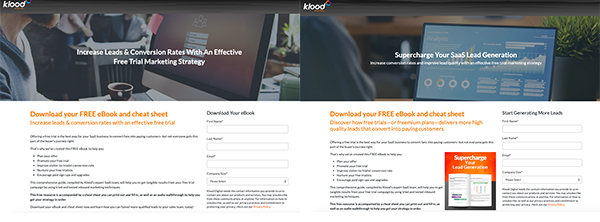
Get weekly
HubSpot updates
You have been working tirelessly on your SaaS marketing strategy, from creating your buyer personas to creating a full-funnel campaign, but how can you make sure all your time and effort has been worth it and will continue to yield results for your business in the future?
Once you’ve pushed your marketing content live, whether it’s a whole new website or a new downloaded content offer, do not make the mistake of thinking that your job is done. You have now entered the reporting and optimisation phase, where you will tweak and improve details of your marketing strategy to improve the ROI of your marketing efforts at every interaction with your prospects.
Reporting effectively
Before you begin reporting figures, be sure your data is accurate. Have you set up filters on your analytics tool to filter out your office IP and any other internal traffic that could skew your figures? If you have external resources who would be visiting your website regularly, such as a marketing agency or website developer, be sure their IPs are also being filtered out. Here’s a step-by-step guide to setting up your filters correctly on Google Analytics.
Once you have a clean set of data to work from, you can start to gauge a baseline reading of your marketing efforts to measure any optimisation against going forward.
Primary metrics all businesses should measure include, but are not limited to:
- Traffic to the website.
- The source of that traffic. For example, how much of it is from organic search and how much is being paid for?
- Landing page conversion rates.
- Lead to customer conversion.
- Call-to-action click-through rates.
Other areas to report on will depend on your core business goals. What are you looking to achieve through your marketing efforts? For example, if you are looking to establish your SaaS business as a thought leader in the industry, you may wish to measure your blog views and subscribers.
Remember to monitor any vital KPIs regularly, such as traffic levels, conversion rates and cost-per-conversion on any paid media, so that you aren’t wasting budget and any sudden issues can be addressed quickly.
Optimisation
Once you have baseline figures to measure against, you can start to see which areas of your marketing may need improving. For example, if you were to launch a new content offer and your landing page’s conversion rate was lower than your baseline, look for ways to improve this by A/B testing the imagery, copy, form length or the targeting of the ads you are sending to it until it’s performing as well as, if not better than, your previous landing pages.

Optimising landing pages
As a rule of thumb, you should be aiming for a benchmark conversion of 20% for your website’s landing pages. These pages are vital to your website’s performance as these are where you capture your visitor’s data.
If you are new to conversion rate optimisation (CRO), this is the area of the website you should focus on first. You’ll see that, with even the smallest optimisation tweaks, you can make a big impact on your lead generation and, ultimately, your company’s bottom line.
Here’s our checklist for landing page optimisation:
- Does it pass the blink test? Can you determine what the landing page is about and who it is targeted at within 5 seconds? If you can’t, you need to rethink your messaging until its crystal clear.
- Do you have an attention-grabbing headline that will appeal to your buyer persona?
- Do you have a relevant image?
- Is your copy clear and compelling?
- Have you removed any unnecessary distractions from the page? Such as the main navigation menu and competing calls-to-action.
- Have you optimised the form?
B2B businesses who A/B test their landing pages can generate up to 30-40% more leads through their websites, and 20-25% more leads on eCommerce. – HubSpot
Optimising website conversion paths
A website conversion path is the series of clicks a user goes through on your website. From the first interaction through to your intended goal or conversion. By including this in your CRO process, you will start to see which pages are generating the most business through your website, allowing you to prioritise these for optimisation and/or investigate why these pages are outperforming the rest of the website and what can be learnt from this.
Firstly, you will want to map out the possible conversion paths a typical user will make through your website. From here, you can assess the conversion metrics on each page and where you are directing users to navigate to, finding any blockers that may cause a user to become frustrated with your website.
At this stage we would also recommend using CRO software, such as Hotjar, that will allow you to set up recording of real visitors to your website to see if users are facing any hurdles when navigating around your website, or if there is anything that will stop them moving further down the sales funnel.
From here, you can set up a test to see if a change in layout, call-to-action colour or copy can help to improve your conversion rates at each level of the conversion path.
Optimising your marketing material
It is essential that all of your SaaS marketing material is systematically reviewed to help keep the content up to date and accurate, especially if you have evergreen campaigns that have been running for a while.
By setting up a review schedule to analyse not only the copy but the layout, styling and topic selection of your marketing material, you will be able to capture any amendments that should be made to help prospects always find the content you’re proud of. This is particularly important for a SaaS company as your offering is likely to continuously undergo upgrades and improvements – you want to make sure that you’re always emphasising the most relevant features of your products and services.
If the content is great, but you’re not seeing the downloads you would expect, then you may wish to consider who you are writing your content for. During your marketing strategy, you will hopefully have worked on your buyer personas and conducted research into their pain points and challenges.
When reviewing your content, are you able to envision your buyer persona wanting to part with their contact details for the content you are providing? Are you offering enough value for the amount of information you are requesting for them to access it? And are you addressing a pain point that they would be researching for?
Interested in seeing how we can help you create a successful marketing strategy? Find out more here.

